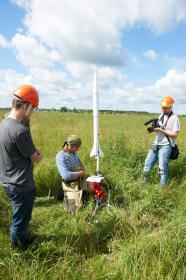
The third championship «СanSat in Russia». Preparing to the rocket's launching. Photo by Alexander Kulaev.
At the beginning of June the satellites were launched in Moscow region. It was not an ordinary launching - the Third championship "CanSat in Russia" took place there. The name of these satellites is originated from "Can" and "Satellite", because the satellite can be placed into the soda water can. The idea of such satellites came from the USA, and the SINP scientists have catched it up and adopted.
For the second time the championship took place in Taldom region near Moscow at the firing range between the villages Severny and Kalinkino. The first championship took place in Kaluga in 2012. As Nikolay Vedenkin, the Technical Director of the "CanSat in Russia" project and SINP scientist, told us, more and more people get interested in it every year, and more and more school students want to take part in the competitions. But only the best teams enter it. At first, they are going through the local competition within the city, the region or the republic; then - through the all-Russia competition, which take place at SINP in winter. At all stages the school students should defend their projects of the satellite. The teams, invited to the championship "CanSat in Russia", prepare the satellites for the launch.
There are two groups of teams at the championship: regular league, consisted of the first-timers, and premier league, consisted of "profs". There are up to three students and one teacher in each team.
The filling of the satellite for regular league includes temperature sensor, atmospheric pressure sensor, radiotransmitting module, processing module - similar to the onboard computer, electronic circuits. The teams buy this equipment for about 10 thousands roubles. The students prefabricate the elements into the single complex, solder, code, test, calculate and manufacture the parachute to guarantee the operation of the satellite and its landing. If they want, they can add any other instrument to the satellite. The weight of the regular league satellite should not increase 350 g. The participants of the premier league should not buy the set, therefore they manufacture their own satellite up to 1 kg weight.
For the launching of the satellites the scientists of SINP MSU prepared the rockets in cooperation with radioamateurs. For the regular league they prepared one-engine rockets with total impulse of 100 N/s. Diamater of the rocket is about 70 mm, height is about 1 m. For the premier league satellites they manufactured guided rockets, including one engine with total impulse of 1600 N/s. Its diameter is 100 mm, height - 2 m. But unfortunately, big rockets for premier league satellites have not passed the tests successfully, so they were replaced with radio-guided pilotless aircraft.
First of all, the rocket for satellites launching should be safe: it should not contain metal. The rocket case and container for the satellite are produced from plastic; stabilizing fins at the rear art of the rocket - from plywood. Engine's case in the form of tube is manufactured from thick paper. It is filled with mixture based on saltpeter.
This year during the Third championship "CanSat in Russia" 15 teams of the regular league and 5 teams of the premier league took part. They came from Moscow, Moscow region, Kaluga, Samara and Samara region, Kazan, Chuvash republik, Sakha-Yakutia republic, Mirny (situated near the famous Russian launching site Plesetsk) and Minks (Belorussia).
Before the start of the competition the referees organized pre-flight tests - they checked the operation of the satellites and their instruments. All defects should be removed immediately.
Then all participants were fitted with hard hats and protective glasses for the case of satellite's or rocket's part falling. During the championship the participants weared clothes covered the body, hands, arms and legs and shoes with high collars in order to protect from the insects.
During the launch everybody exept the group responsible for this launch sheltered in army tents, situated 500 meters far from the launching site.
How the rocket was launched? The launching group pressed the start buttom. Electric current ran along the tire and fired the lighter, which in turn fired the engine's fuel. Its burning was slowed down by sulfur in order the rocket reach the needed altitude. Then pyrotechnics exploded, driving out the satellite into the sky.
The regular league satellite was thrown from the rocket at the altitude of about 200 m above the Earth, then the parachute or the tape was released immediately, therefore it landed within the radius of 1 km. The premier league satellite was thrown from the radio-guided aircraft at the altitude of 700 meters, the parachute or the tape was released at 200 meters, and the satellite landed within the radius of 1 km. The students had to find the satellites. If the satellite began to plane at the altitude of 3 km, as it happened during the First championship, than the region of landing could be up to 8 km in radius, and it would be a great problem to find the satellite.
During the flight of the satellite ground-based receiving station got information from it. Then the students prepared a report basing on the obtained data.
The team "Rara avis" from the Moscow school 1155 won the Third championship among the regular league participants, and the team "BeSat" from the Minsk liceum of the Belorussian state university became the winner among the premier league.
